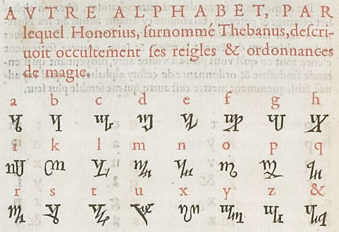Theban alphabet

The Theban alphabet (also Angels font , angel alphabet , alphabet of Honorius or witches alphabet ) is a system of writing of unknown origin. It consists of 24 characters and is mainly used to cover up secret texts.
origin
The Theban alphabet was published for the first time in 1508 in the Polygraphiæ libri sex of the Benedictine abbot Johannes Trithemius (1462–1516), who ascribed the alphabet to Honorius of Thebes , referring to an unspecified “fourth large book” by the Italian astrologer Pietro d'Abano ( 1250–1316).
Trithemius' pupil Heinrich Cornelius Agrippa von Nettesheim (1486-1535) mentions the Honorius alphabet in the third volume of his De occulta philosophia libri tres , which appeared two years later , taking over the information from Trithemius.
In Francis Barrett's treatise The Magus , published in 1801, the Theban alphabet is listed along with other sigil alphabets with reference to Honorius von Thebes and integrated into Barrett's magical system.
Structure and intended use
The alphabet was not developed for a single language, but has always been used to cover up secret texts in one's own language, or Latin . Trithemius calls the purpose in his Polygraphiæ "the hiding of the follies of magic", while Agrippa says it should "keep the secrets of the gods and the names of the spirits hidden from the eyes of worldly people ".
The 24 characters of the system can be mapped to the letters of the Latin alphabet , but the letters j, u, and w have no equivalent. There is also another symbol, which is commonly interpreted as a sign for the end of a sentence. Words are separated from one another by spaces or a punctuation , no further punctuation marks or numbers are described. No distinction is made between upper and lower case . The Theban alphabet is a monoalphabetic substitution that does not provide effective protection against unauthorized decryption.
In modern times the Theban alphabet is used by neo- pagans. The system is particularly common within the Wicca movement, after its founder Gerald Brousseau Gardner (1884–1964) took it from Agrippa's writings.
The characters
 |
 |
 |
 |
 |

|
| A. | B. | C. | D. | E. | F. |
 |
 |
 |
 |
 |

|
| G | H | I. | K | L. | M. |
 |
 |
 |
 |
 |

|
| N | O | P | Q | R. | S. |
 |
 |
 |
 |
 |

|
| T | V | X | Y | Z | end of sentence |
Web links
- "Theban Alphabet" in Omniglot (English)
- Information on the side of Coven of Cythrawl (English)
swell
- ↑ a b c Eric S. Raymond : Proposal to add the Theban Alphabet to ISO / IEC 10646 . February 26, 2002, accessed May 15, 2015.
Agrippa from Nettesheim
- ^ Heinrich Cornelius Agrippa von Nettesheim : De occulta philosophia libri tres . Cologne 1533. There chapter 29 De characteribus & sigillis spirituum . Scan of the copy from the Library of Congress . Text reproduction after Henrici Cornelii Agrippæ from Nettesheym: Armatæ Militæ Eqvitis Avrati, et ivris vtriivsqve ac medicinæ doctoris, opera omnia in dvos tomos concinne digesta . Strasbourg 1600. Page 307f., Digitized page 307 with text passage , digitized page 308 with print of the alphabet , English translation: Of Occult Philosophy, Book III
- ↑ “sacra deorum & spirituu nomina a prophanorum versu lectioneque custodientes”, Agrippa 1533.
Johannes Trithemius
- ^ Johannes Trithemius : Polygraphiæ libri sex . 1508. Text reproduction here to Basel 1518. Page 497f. It says u. a. “Petrus de Abano testatur in suo maiore libro qarto” digitized p. 497 with an imprint of the text passage , digitized p. 498 with an imprint of the alphabet
- ↑ "magicis fatuitates ascondit", Trithemius 1508.



